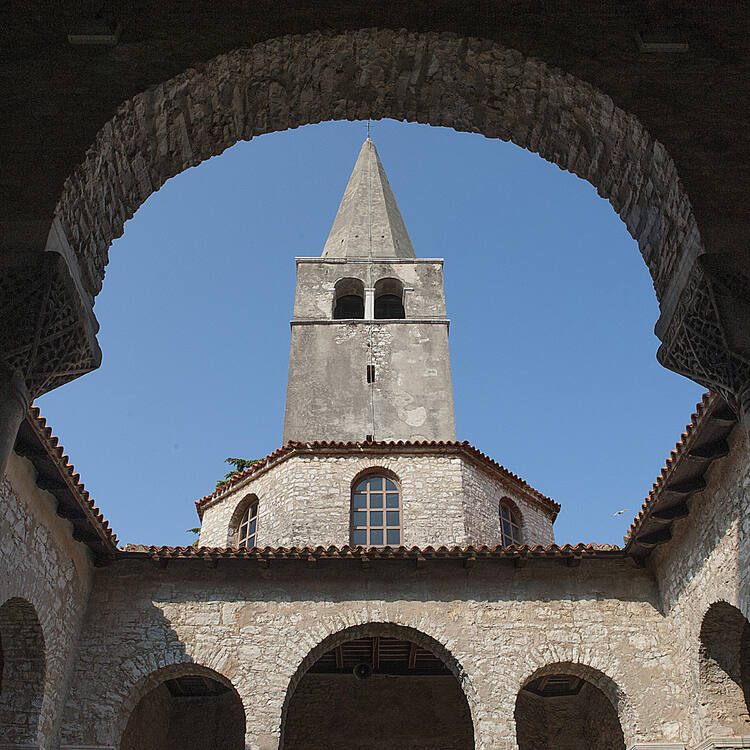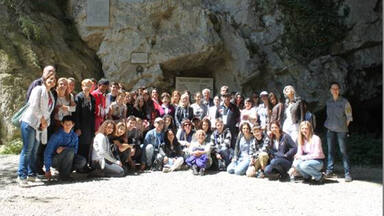Episcopal Complex of the Euphrasian Basilica in the Historic Centre of Poreč
Episcopal Complex of the Euphrasian Basilica in the Historic Centre of Poreč
The group of religious monuments in Porec, where Christianity was established as early as the 4th century, constitutes the most complete surviving complex of its type. The basilica, atrium, baptistery and episcopal palace are outstanding examples of religious architecture, while the basilica itself combines classical and Byzantine elements in an exceptional manner.
Description is available under license CC-BY-SA IGO 3.0
Ensemble épiscopal de la basilique euphrasienne dans le centre historique de Poreč
Le groupe de monuments religieux de Porec, lieux de culte de la chrétienté dès le IVe siècle, constitue l'ensemble préservé le plus complet de ce type. La basilique, l'atrium, le baptistère et le palais épiscopal sont de remarquables exemples d'architecture religieuse, tandis que la basilique elle-même associe de manière exceptionnelle des éléments classiques et byzantins.
Description is available under license CC-BY-SA IGO 3.0
مجموعة أسقفيّة لبازيليك السيدة العذارء في وسط بوريك التاريخي
تشكّل مجموعة النصب التاريخيّة في بوريك، دار عبادة الديانة المسيحيّة منذ القرن الرابع، المجموعة الأكثر شموليّةً المحفوظة من هذا النوع. وتشكّل البازيليك والساحة وبيت العماد والقصر الأسقفي أمثلةً استثنائيّةً عن الهندسة الدينيّة في حين أنّ البازيليك نفسها تجمع بصورة استثنائيّة بين عناصر كلاسيكيّة وبيزنطيّة.
source: UNESCO/CPE
Description is available under license CC-BY-SA IGO 3.0
波雷奇历史中心的尤弗拉西苏斯大教堂建筑群
波雷奇的宗教建筑群是基督教徒于4世纪初建造的,是同类建筑中保存最完整的建筑群。长方形的大教堂、正厅、洗礼池和主教殿是宗教建筑的典型代表,同时长方形的大教堂本身还以一种特殊的方式融合了古典与拜占庭风格。
source: UNESCO/CPE
Description is available under license CC-BY-SA IGO 3.0
Комплекс базилики епископа Ефразия в историческом центре города Пореч
Группа религиозных памятников в городе Пореч, где христианство установилось еще в IV в., является самым целостным из всех дошедших до наших дней подобных ансамблей. Базилика, атриум, баптистерий, епископский дворец – все это выдающиеся примеры религиозной архитектуры. В архитектуре базилики своеобразно сочетаются классические и византийские элементы.
source: UNESCO/CPE
Description is available under license CC-BY-SA IGO 3.0
Conjunto episcopal de la basílica eufrasiana en el centro histórico de Poreč
Lugares de culto de la cristiandad desde el siglo IV, los monumentos religiosos de Poreč forman el conjunto conservado más completo en su género. La basílica, el atrio, el baptisterio y el palacio episcopal son ejemplos notables de arquitectura religiosa. En la basílica se puede observar una asociación excepcional entre elementos clásicos y bizantinos.
source: UNESCO/CPE
Description is available under license CC-BY-SA IGO 3.0
ポレッチ歴史地区のエウフラシウス聖堂建築群
この聖堂の起源はキリスト教がこの地に伝わった4世紀に溯るが、これは5世紀の聖堂に代えて司教エウフラシウスが6世紀に建立したもの。聖堂全体に同時代のラヴェンナの影響が強く見られる。中央アプシスと勝利門のモザイクは保存が良好である。source: NFUAJ
Bisschopscomplex van de Euphrasius basiliek in het historisch centrum van Poreč
Dit bisschopscomplex bestaat uit een groep religieuze monumenten in het historisch centrum van Poreč, waar het christendom zich al in de 4e eeuw vestigde. Het is uniek omdat alle elementen van het vroegchristelijke complex bewaard zijn gebleven. De basiliek, het atrium, de doopkapel en het bisschopspaleis zijn voorbeelden van religieuze architectuur. De basiliek werd in de 6e eeuw door Euphrasius gebouwd en de bouwstijl combineert klassieke en Byzantijnse elementen. De vroegste fase van de basiliek – een eenvoudige kapel in een groot Romeins woonhuis waar de botten van de plaatselijke martelaar Maurus werden geplaatst – is gedateerd rond 313.
Source: unesco.nl
Outstanding Universal Value
Brief synthesis
The Episcopal Complex of the Euphrasian Basilica in the Historic Centre of Poreč is an outstanding example of an early Christian episcopal ensemble that is exceptional by virtue of its completeness and its unique basilican cathedral and that is a representative of a stylistically important episcopal palace. It is, furthermore, a structural ensemble and, when taken with the archaeological remains of several earlier building phases, it forms part of a greater unit, namely, the historic town of Poreč. As such it provides the unifying factor for cultural, urban, and architectural history beyond the cathedral complex, and developed into the late classical and early medieval town when the Episcopal Complex of the Euphrasian Basilica was established.
The present church was built in the mid-6th century by Bishop Euphrasius on the north coast of the peninsula where the town developed. The latest series of churches on the site incorporate parts of its predecessor. Euphrasius also built an atrium beyond the narthex of the basilica, a baptistery at the end of the atrium, a monumental episcopal palace between the atrium and the sea, and a small memorial chapel north-east of the basilica. The Kanonika (Canon’s House) was added in 1257, followed by the belltower in the 16th century, and by smaller buildings such as the 15th century sacristy and chapels of the 17th and 19th centuries.
Euphrasius’ basilica is three aisled with a large central apse flanked by two smaller ones. Its plain columns have carved capitals, linked by arcading. In the main apse there are mosaics around the four windows, in the semi-dome and on the front wall. There are remains of other decoration of various dates in the church. The memorial chapel is of a trefoil-shaped plan, the apses being round inside and polygonal outside. The baptistery and atrium conserved the original form. Some remains of the earlier churches discovered in archaeological excavations are on display. Only small traces of the 6th-century bishop’s palace survived.
Criterion (ii): The episcopal Complex of the Euphrasian Basilica is an outstanding example of an early Christian ensemble reflecting the development of Christian ecclesiastical architecture and planning within the late Roman and Byzantine Empire.
Criterion (iii): The Episcopal Complex of the Euphrasian Basilica in the Historic Centre of Poreč is an outstanding example of an early Christian episcopal ensemble that is exceptional by virtue of its completeness and its unique Basilican cathedral.
Criterion (iv): The Episcopal Complex of the Euphrasian Basilica is the most complete surviving complex of this type. The basilica, atrium, baptistery, and episcopal palace are outstanding examples of religious architecture, whilst the basilica itself combines classical and Byzantine elements in an exceptional manner.
Integrity
The Complex of the Euphrasian Basilica in the Historic Centre of Poreč is the best preserved early Christian cathedral complex with all the parts of the original structure so integrally preserved: the church, memorial chapel, atrium, baptistery and particularly the bishop’s residence are outstanding in their level of preservation. All these structures are included within the inscribed property. All these buildings have almost entirely preserved their original structures. The exceptional quality of the complex lies in the completeness and compactness of the group and its intimate relationship with its historic town.
There are risks of natural disaster and the property may suffer from development pressures or tourism pressure. Relative humidity as a result of the sea level rise caused by climate change is currently the main issue.
Authenticity
The authenticity of the Euphrasian episcopal complex is an exemplary illustration of historical multistratification, in the spirit of the 1964 Venice Charter. Restoration work has been carried out here from the Middle Ages up to the present day, according to the perceptions and philosophies of the succeeding periods. The results of this continuous activity have become intrinsic parts of the monument itself and bestow a special value on it as witnesses to historical change.
Protection and management requirements
The Euphrasian Basilica is a cultural property designated according to the 1999 Cultural Monuments Protection Act. As a result, any intervention requires authorization by the competent local conservation department. The complex is owned by the Poreč and Pula Episcopal Ordinariate. It retains its function as the cathedral of the Poreč and Pula Diocese, although the residence of the bishop moved from the Bishop's Palace in 1992 which is now, together with the archaeological area, in use as a museum. The management plan provides for the church, sacristy, atrium, and baptistery to retain their active ecclesiastical functions.
The Croatian Restoration Institute manages restoration works on the property according to priorities set by the condition of the structure and the finances provided by the Ministry of Culture and Media.
The general state of conservation is good. In regards to long term management, sea level rise caused by climate change is the main issue to address to prevent moisture related deterioration of the structures.


